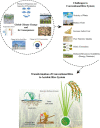Recent trends in nitrogen cycle and eco-efficient nitrogen management strategies in aerobic rice system
- PMID: 36092421
- PMCID: PMC9453445
- DOI: 10.3389/fpls.2022.960641
Recent trends in nitrogen cycle and eco-efficient nitrogen management strategies in aerobic rice system
Abstract
Rice (Oryza sativa L.) is considered as a staple food for more than half of the global population, and sustaining productivity under a scarcity of resources is challenging to meet the future food demands of the inflating global population. The aerobic rice system can be considered as a transformational replacement for traditional rice, but the widespread adaptation of this innovative approach has been challenged due to higher losses of nitrogen (N) and reduced N-use efficiency (NUE). For normal growth and developmental processes in crop plants, N is required in higher amounts. N is a mineral nutrient and an important constituent of amino acids, nucleic acids, and many photosynthetic metabolites, and hence is essential for normal plant growth and metabolism. Excessive application of N fertilizers improves aerobic rice growth and yield, but compromises economic and environmental sustainability. Irregular and uncontrolled use of N fertilizers have elevated several environmental issues linked to higher N losses in the form of nitrous oxide (N2O), ammonia (NH3), and nitrate (NO3 -), thereby threatening environmental sustainability due to higher warming potential, ozone depletion capacities, and abilities to eutrophicate the water resources. Hence, enhancing NUE in aerobic rice has become an urgent need for the development of a sustainable production system. This article was designed to investigate the major challenge of low NUE and evaluate recent advances in pathways of the N cycle under the aerobic rice system, and thereby suggest the agronomic management approaches to improve NUE. The major objective of this review is about optimizing the application of N inputs while sustaining rice productivity and ensuring environmental safety. This review elaborates that different soil conditions significantly shift the N dynamics via changes in major pathways of the N cycle and comprehensively reviews the facts why N losses are high under the aerobic rice system, which factors hinder in attaining high NUE, and how it can become an eco-efficient production system through agronomic managements. Moreover, it explores the interactive mechanisms of how proper management of N cycle pathways can be accomplished via optimized N fertilizer amendments. Meanwhile, this study suggests several agricultural and agronomic approaches, such as site-specific N management, integrated nutrient management (INM), and incorporation of N fertilizers with enhanced use efficiency that may interactively improve the NUE and thereby plant N uptake in the aerobic rice system. Additionally, resource conservation practices, such as plant residue management, green manuring, improved genetic breeding, and precision farming, are essential to enhance NUE. Deep insights into the recent advances in the pathways of the N cycle under the aerobic rice system necessarily suggest the incorporation of the suggested agronomic adjustments to reduce N losses and enhance NUE while sustaining rice productivity and environmental safety. Future research on N dynamics is encouraged under the aerobic rice system focusing on the interactive evaluation of shifts among activities and diversity in microbial communities, NUE, and plant demands while applying N management measures, which is necessary for its widespread adaptation in face of the projected climate change and scarcity of resources.
Keywords: aerobic rice; agronomic practices; current trends; eco-efficiency; microbial activities; nitrogen cycle.
Copyright © 2022 Farooq, Wang, Uzair, Fatima, Fiaz, Maqbool, Rehman, Yousuf and Khan.
Conflict of interest statement
The authors declare that the research was conducted in the absence of any commercial or financial relationships that could be construed as a potential conflict of interest.
Figures






References
-
- Abbasi H., Vasileva V., Lu X. (2017). The Influence of the Ratio of Nitrate to Ammonium Nitrogen on Nitrogen Removal in the Economical Growth of Vegetation in Hybrid Constructed Wetlands. Environments 4:24. 10.3390/environments4010024 - DOI
-
- Ainsworth E. A. (2008). Rice production in a changing climate: a meta-analysis of responses to elevated carbon dioxide and elevated ozone concentration. Glob. Chang. Biol. 14 1642–1650. 10.1111/J.1365-2486.2008.01594.X - DOI
Publication types
LinkOut - more resources
Full Text Sources

